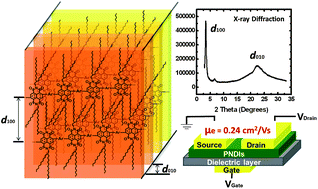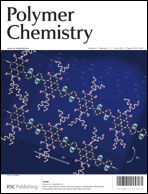New n-type polymer semiconductors based on naphthalene diimide and selenophene derivatives for organic field-effect transistors†
Abstract
n-Type conjugated polymers based on naphthalene diimide (NDI) and various selenophene derivatives have been synthesized, characterized and evaluated as semiconductors for n-channel organic field-effect transistors (OFETs). The new poly(naphthalene diimides) (PNDIs) have weight average molecular weights of 12–107 kDa with a polydispersity of 1.1–2.6. These PNDIs combined a constant electron affinity of 3.9 eV with an optical band gap that varies from 1.7 eV in PNDISS to 1.4 eV in ePNDIBS due to intramolecular charge transfer. X-ray diffraction analysis of films of the polymers revealed a lamellar crystalline structure in which the lamellar interchain distance varied from 2.45 nm in PNDISS to 2.75 nm in PNDIBDS while the π-stacking distance varied from 0.397 nm in PNDIBDS to 0.443 nm in PNDISS. Average field-effect electron mobility of 0.008 to 0.24 cm2 V−1 s−1 with high on/off current ratio (104 to 106) was observed from the bottom gate/top contact n-channel OFETs. A 3.4-fold enhancement in electron mobility was observed in phenyl end-capped and high molecular weight ePNDIBS whereas such end-capping had no effect on the electron mobility in PNDISS and PNDIBDS.


 Please wait while we load your content...
Please wait while we load your content...